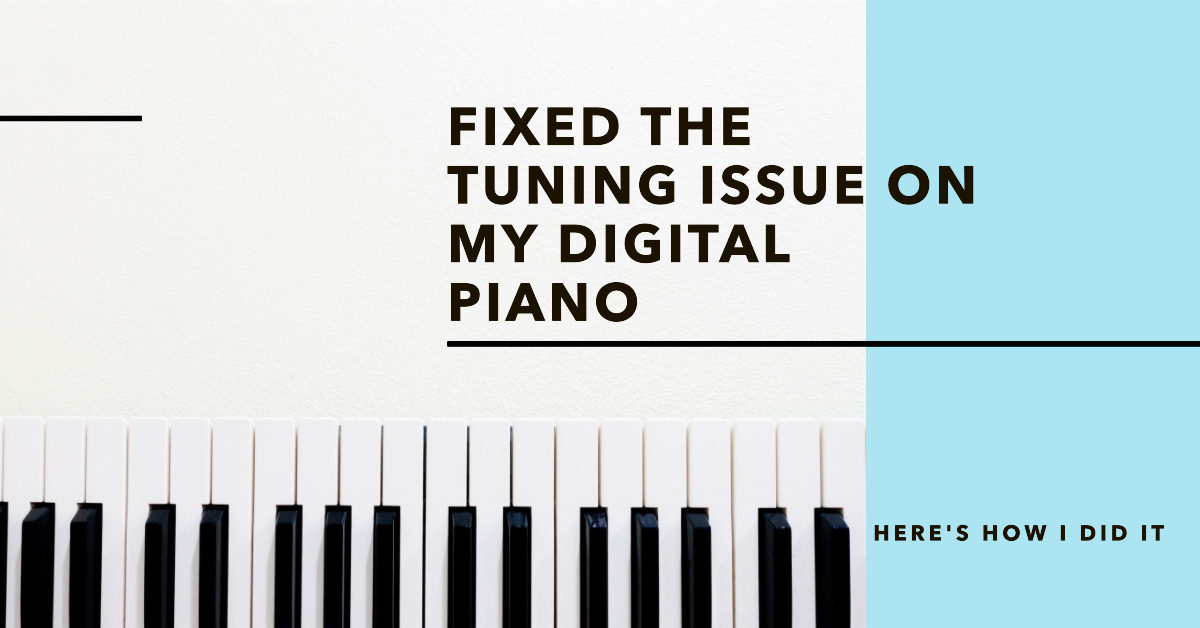Hello, fellow music aficionados! My name is Pallav, and I’ve spent a good chunk of my life perfecting the art and science of music, particularly focusing on those beautiful instruments we call digital pianos.
There’s an undeniable charm to a perfectly tuned piano, the kind that resonates through your body and soul, creating a melody that transcends reality. However, like any piece of technology, digital pianos sometimes fall short of that exquisite harmony we crave so much. And this, my friends, brings us to the topic at hand: tuning issues on a digital piano.
Digital pianos, unlike their acoustic counterparts, are usually lauded for their reliability in maintaining their tuning. Yet, they’re not immune to the occasional glitch or misstep that may throw your keys into sonorous chaos.
In my journey, I’ve been a troubadour, a technician, a tuner, and a teacher, but most importantly, I’ve been a student of this sublime instrument, always learning, always growing. So, when my beloved digital piano started misbehaving, I embarked on a quest to fix the tune, one note at a time.
The value of a well-tuned digital piano is immeasurable – it’s the foundation of beautiful music, the linchpin of captivating performances. With the right tune, your piano becomes an extension of you, effortlessly reflecting your emotions through the language of music. But when it’s off, even slightly, the discord can feel like a wrench in your harmonious world. Let’s delve into the story of how I fixed my piano, and hopefully, inspire you to do the same with yours.
Understanding the Tuning Issue
One day, in the middle of a soulful rendition of Beethoven’s Moonlight Sonata, I noticed something amiss. There was a jarring note, a sharp, slightly out-of-tune blip that turned the serene melody into a musical hiccup. I paused, puzzled. Digital pianos, being the steadfast companions they are, aren’t supposed to waver in their tuning. Yet, the evidence was clear as a discordant C# reverberated through my studio. My trusted instrument was off-tune.

The symptoms of a tuning problem in a digital piano can be subtle or glaringly apparent. In my case, certain keys were striking notes that sounded off-kilter, a significant deviation from their normally consistent pitch.
So, what could be the cause of these tuning issues in digital pianos? The possible culprits are many: it could be an issue with the digital sampling that underlies the piano’s sound, a software glitch, or even a hardware failure. In essence, anything that interferes with the intricate digital machinery of your piano can potentially disrupt its tuning.
The impact of these tuning problems can’t be underestimated. It affects not just the performance of your piano but your performance as well. A piano’s tuning is like a dance partner’s rhythm: if it’s off, you both stumble. The notes become jarring, the melodies disjointed, and the magic of the music starts to fade.
Understanding the issue is the first step towards fixing it, and so, with resolve as steady as a metronome’s tick, I set out to uncover the source of my piano’s dissonance. It was time for some research and preparation.
Research and Preparation
Before diving headfirst into the mechanical workings of a digital piano, it’s important to arm yourself with knowledge. Like a seasoned detective, I knew that understanding the intricacies of my instrument would lead me to the solution. The internet became my library, and I began poring over forums, technical manuals, and expert guides to understand the possible causes of the tuning issue.
I consulted various resources including manufacturer guidelines, tuning tutorial videos, and piano technology books. To my surprise, I found a vibrant online community of piano lovers who had faced similar issues and were more than happy to share their insights. It was both a learning opportunity and a reassurance that I wasn’t alone in my quest for the perfect tune.
As I delved deeper, I realized that fixing a digital piano might require some tools. For software-related issues, an updated version of the piano’s firmware, a computer, and an interface cable would be required. If it was a hardware problem, I might need some basic electronic tools. Thus, I made sure to have all these resources at my disposal, ready to tackle whatever issue I might uncover.
Research and preparation are the unsung heroes of any successful endeavor. They not only equip you with the knowledge and tools necessary to face the problem at hand but also provide the confidence to take on the challenge. With a thorough understanding of the potential causes and fixes of the tuning issue, I was ready to identify the specific problem with my piano.
Identifying the Specific Problem
With the knowledge I had amassed and my toolkit in hand, it was time to enter the heart of the matter – identifying the tuning issue that had turned my harmonious haven into a cacophonous mess.
The first step was to diagnose the problem, a process that involved a series of checks and tests. I started by playing each key individually, listening carefully for any notes that were off. A good tip here is to use a tuning app on your phone or any device that can accurately measure pitch. This can provide a more objective perspective on whether a note is off-tune or not.
Once I identified the problematic keys, I dug deeper into their mechanics. For a digital piano, this could mean checking the connections, ensuring the software was up-to-date, or even looking at the hardware components involved. It’s important to remember to tread carefully here. Digital pianos are complex machines, and one misplaced screwdriver can lead to more harm than good.
The identification process wasn’t without its hurdles. The biggest challenge I faced was understanding the digital lingo – MIDI, DSP, sampling rate, bit depth – it felt like a foreign language at first. However, with patience and persistence, I managed to decipher the digital jargon.
In the end, after a series of tests and a close inspection of the hardware, I was able to pinpoint the issue. It was a software glitch, a relief as it’s typically easier to handle than a hardware problem. With the problem identified, I was one step closer to restoring my digital piano to its harmonious self. Now it was time to fix the tuning issue.
Fixing the Tuning Issue
With the issue identified, I was now standing on the precipice of resolution. It was time to roll up my sleeves and get to work. There’s something beautiful about solving a problem, about turning the cacophony into a symphony. It’s like threading a needle of sound, creating a seam of harmonious notes. Here’s how I went about fixing the tuning issue on my digital piano.
Firstly, I needed to address the software glitch. Updating the software often resolves such issues, and it’s usually straightforward. I followed the manufacturer’s guidelines, ensuring I had the correct and most recent version of the software. Just like that, half of the battle was won.
It’s worth noting that if you suspect hardware issues with your piano, there are great resources that can guide you. For instance, if there are broken keys, the guide on how to fix broken keys provides a comprehensive step-by-step process to address the issue. Similarly, if the problem is with the sustain pedal, you can refer to the guide on fixing the sustain pedal.
Now, let’s walk through the rest of the tuning process, step by step. Once the software was updated, I restarted the piano and played through the scales again, carefully listening to each note. To my relief, the discordant notes had been tamed, returning to their beautiful selves.
Here are a few tips for those venturing into the world of digital piano tuning:
- Patience is key: Whether it’s updating software or fixing a key, the process takes time. Don’t rush. The goal is to restore harmony, and that can’t be rushed.
- Trust your ears, but use tools too: Your ears are your best tool, but don’t disregard the value of tuning apps or any other technology that can help.
- When in doubt, seek help: The internet is teeming with advice and tutorials. The guide on how to tune a piano is one such helpful resource.
With the tuning issue fixed, it was time to ensure that the problem had indeed been solved. It was time for testing and verification.
Testing and Verification
After implementing the necessary fixes to address the tuning issue, it was crucial to ensure that my digital piano was now back in harmony. Testing and verification became my final steps in this musical journey.
To test the effectiveness of the fixes, I performed a series of checks. I played various scales, arpeggios, and chords, paying close attention to the consistency and accuracy of the notes. I wanted to ensure that the keys were responding correctly and producing the intended pitch. It was a beautiful moment when the melodies flowed seamlessly, with no hint of the previous discord.

In addition to the subjective evaluation through playing, I also employed objective measures. I utilized tuning apps and digital tuners to verify the accuracy of the notes. By comparing the digital readings to the desired pitch, I could confirm that my digital piano was now finely tuned.
With each test and check, my confidence grew, and a smile crept across my face as I witnessed the fruits of my labour. The tuning issue that once plagued my piano was now a distant memory.
The results and improvements were not just auditory but also palpable. Playing became effortless, my musical expressions more vibrant and nuanced. The beauty of the instrument, its ability to connect with my emotions, was fully restored.
For anyone embarking on a similar journey, I encourage you to thoroughly test and verify the fixes you apply. Trust your ears, rely on digital tools, and ensure that the tuning issue is truly resolved before declaring victory.
With my digital piano singing in perfect tune once again, it was time to reflect on the importance of regular maintenance and consider future considerations. Let’s explore those aspects in the next section.
Maintenance and Future Considerations
Maintaining the tuning and overall health of your digital piano is essential to ensure its longevity and optimal performance. As with any instrument, regular care and attention will go a long way in preventing future tuning issues. Here are some key points to consider for maintenance and future-proofing your digital piano.
A. Regular Maintenance: Schedule periodic maintenance sessions for your digital piano. This includes cleaning the keys and surfaces, inspecting the internal components, and ensuring proper connections. Dust and debris can accumulate over time, affecting the performance and even the tuning of your instrument. By keeping it clean and free from any obstructions, you can maintain its optimal functionality.
B. Environmental Considerations: Digital pianos are sensitive to changes in temperature and humidity. Extreme fluctuations can affect the internal components and lead to tuning problems. Keep your piano in a controlled environment, away from direct sunlight, heat sources, and excessive humidity or dryness. Using a hygrometer and a humidifier or dehumidifier, depending on your location, can help maintain a stable environment for your instrument.
C. Proper Handling and Usage: Treat your digital piano with care. Avoid placing heavy objects on top of it, as this can put unnecessary stress on the keys and internal mechanisms. Also, be mindful of how you play the piano. Excessive force or improper technique can lead to mechanical issues and affect the overall tuning stability.
D. Regular Tuning Check-ups: While digital pianos are designed to maintain their tuning, it’s still a good idea to periodically check the tuning and make any necessary adjustments. You can use a digital tuner or tuning app to ensure the accuracy of the notes. If you notice any deviations, consult the manufacturer’s guidelines or seek professional assistance to fine-tune your instrument.
E. Software and Firmware Updates: Stay up-to-date with the latest software and firmware releases for your digital piano. Manufacturers often release updates to address known issues, improve performance, and enhance features. Regularly check for updates and follow the recommended procedures to keep your instrument running smoothly.
By following these maintenance practices and future considerations, you can minimize the chances of encountering tuning issues in the future and prolong the life of your digital piano. Remember, a well-maintained instrument will continue to provide you with endless hours of musical enjoyment.
Conclusion
In the symphony of life, a well-tuned piano is a melody waiting to be played. As I reflect on the journey of fixing the tuning issue on my digital piano, I am filled with a sense of accomplishment and a deeper appreciation for the artistry of this magnificent instrument.
Throughout this process, I learned that understanding the nature of the problem is crucial. By observing the symptoms and investigating potential causes, I was able to identify the specific issue affecting my piano’s tuning. Research and preparation provided me with the knowledge and resources necessary to embark on the journey of fixing it.
With patience and perseverance, I followed the steps outlined, addressing both software and hardware aspects as needed. The testing and verification phase confirmed the success of my efforts, as the harmonious melodies resonated once again.
Maintenance emerged as an integral part of the equation. By nurturing the well-being of my digital piano, I can safeguard its tuning and overall performance for years to come. Regular care, environmental considerations, and periodic tuning check-ups are essential in maintaining its optimal functionality.
This experience has taught me that the journey of fixing a tuning issue on a digital piano is not merely a technical endeavour; it is an artistic endeavour that requires both precision and creativity. It reminds us of the delicate balance between art and technology, where the mechanics serve as a vessel for our musical expression.
As I bid farewell to the tuning issue that once disrupted the harmony of my digital piano, I encourage all fellow pianists and music enthusiasts to embrace the importance of a well-tuned instrument. The magic of music lies not only in the notes we play but also in the quality of their resonance.
May your pianos sing with the perfect tune, carrying your melodies to the highest realms of musical bliss. Cherish the journey of fixing and maintaining your instrument, for in doing so, you nourish the soul of your music.
Remember, dear readers, a well-tuned piano is not just an instrument; it is a portal to enchantment, an invitation to create, and a companion on your musical voyage. Embrace its tune, and let it carry you to the realms of pure musical bliss.





